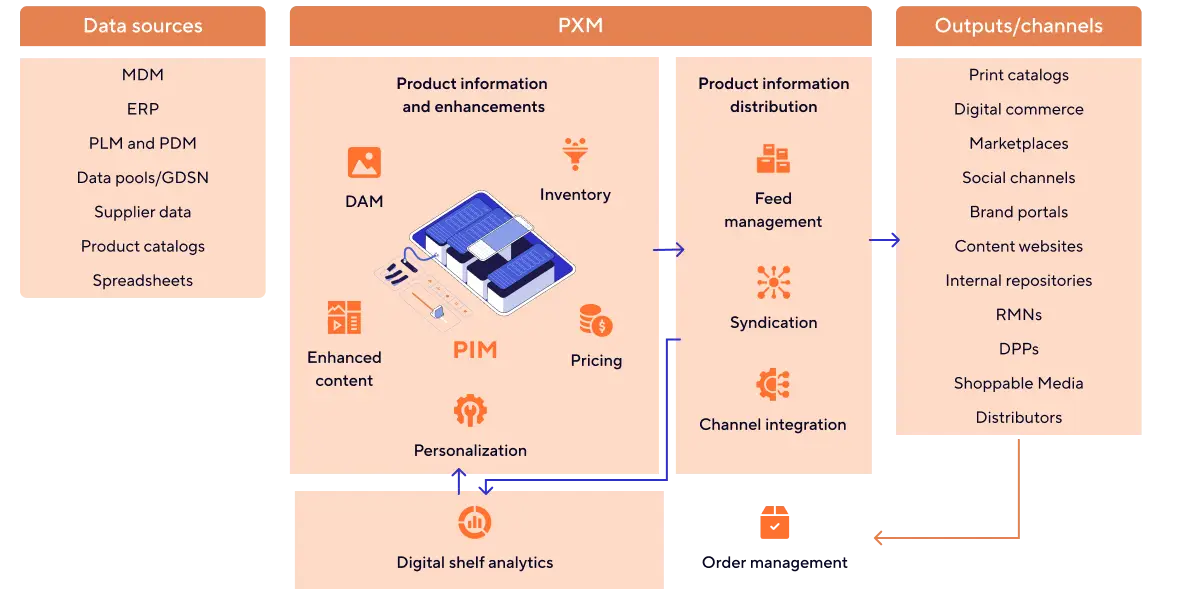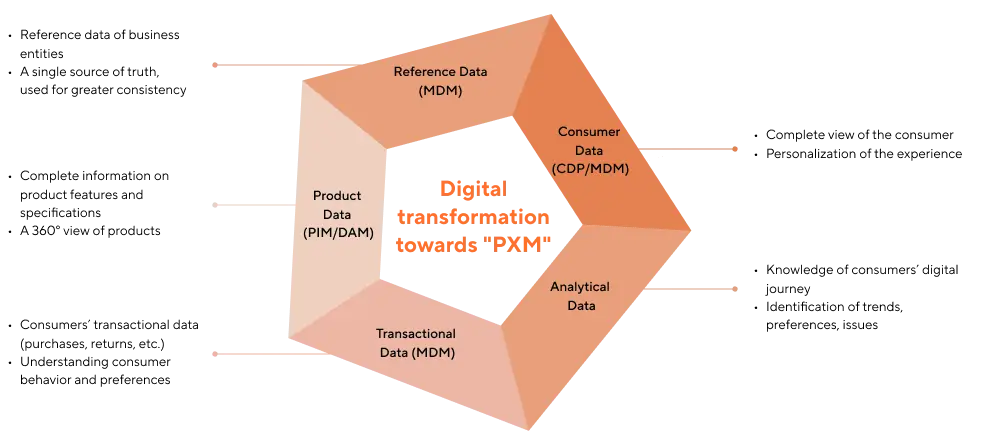How to shift from an “Information”-driven approach (PIM) to an “Experience”-driven approach (PXM)?

Faced with increasingly connected and demanding consumers, simple Product Information Management (PIM) is no longer enough. Brands must now go beyond raw data to deliver an enriched, contextualized, and omnichannel product experience.
This is precisely the promise of Product Experience Management (PXM). Building on a solid PIM foundation, PXM transforms product data into a true driver of conversion and loyalty. It’s no longer just about distributing the right product information, but about delivering the right experience, at the right time, on the right channel.
This paradigm shift requires technological, organizational, and cultural transformation. It has become essential to rethink how product data is collected, enriched, distributed—and leveraged to strengthen customer relationships.
What you will learn in this article:
-
Why PIM alone can no longer meet consumer and digital channel expectations
-
What PXM really is and how it builds on PIM without replacing it
-
How PXM enhances consistency, personalization, and overall product experience performance
-
The organizational, technical, and regulatory challenges tied to this transformation
-
The main obstacles to anticipate when implementing a PXM strategy
-
Practical advice for structuring your approach effectively, aligned with existing systems
-
The role of AI in automating, enriching, and personalizing product content
What is PXM?
According to Gartner, PXM refers to the set of applications designed to optimize the creation, distribution, execution, and analysis of product data across different sales channels. PXM complements PIM but does not replace it.
See also: What is a PIM?

PXM delivers timely, accurate, consistent, and enriched product information—essential for brand control, customer engagement, and improving sales conversion across a variety of channels.
PXM encompasses a more holistic approach to a brand’s digital presence, going beyond product data by integrating a 360° view of it across every channel where it is consumed. Its ultimate goal remains driving digital sales growth—while ensuring continuous optimization over time.
Why PXM?
It’s no secret: consumers demand personalized and seamless shopping experiences across all digital channels they use. The number of these channels is constantly increasing, and brands must be present on each of them.
The complexity of product data, along with its growing volume, puts pressure on brands not only to manage it efficiently but also to ensure consistency and accuracy across multiple platforms.
On top of that, stricter regulatory requirements continue to emerge around product accuracy, compliance, and sustainability (e.g., AGEC law, Digital Passport).
The key objective remains maintaining a consistent presence across all channels—while accounting for the many stakeholders involved in product data.
For businesses, this makes it essential to:
-
Ensure tight integration between systems managing product data and those delivering the customer experience
-
Guarantee smooth data exchange across these systems
-
Leverage product data to personalize experiences

A few tips to get started with PXM
Implementing a PXM strategy can sometimes face the following challenges:
-
The organization’s level of maturity regarding product data and its implications
-
Complex integrations with legacy systems
-
Difficulties in global organizations, with separate business units relying on different systems
-
Role confusion between systems such as PIM, MDM, DAM, ERP, DXP… which can hinder PXM deployment
Best practices for deploying PXM
-
Prioritize integrating your source data into a PIM as the first step
-
Involve marketers and experts in a collaborative process of product data entry and enrichment
-
Identify the channels where your products are currently offered, as well as those you would like to expand into
-
Create personalized content for each channel, leveraging both traditional and emerging ones
-
Explore the PXM-related features offered by PIM or MDM vendors—whether native or through add-on modules (e.g., syndication)
-
Implement processes for feeding sales and analytics data back into your product information for continuous enrichment
And what about AI in PXM?
AI is often already embedded within your PIM, MDM, or other systems contributing to PXM, supporting tasks such as:
-
Optimization: automated classification, field normalization
-
Enrichment: content generation, image addition
-
Translation
Additionally, conversational agents can be integrated to execute tasks automatically or trigger actions based on notifications from different systems.
The shift from PIM to PXM is already underway, largely driven by its composable, customer-centric approach—an approach increasingly reflected in the models proposed by major vendors (Pimcore, MaPs System, Akeneo). Strongly process-oriented, PXM requires finding the right balance between the “simplicity” of an all-in-one solution and the potential power of a best-of-breed suite.
This evolution of PXM goes beyond a technological platform—it also transforms how businesses operate, serve their customers, and succeed in the era of digital efficiency.
DATASOLUTION experts are available to support you in studying and implementing a PXM strategy within your organization.
Feel free to contact them via the form below.
FAQ – Everything you need to know about the transition from PIM to PXM
-
What is the difference between PIM and PXM?
PIM (Product Information Management) centralizes, structures, and distributes product information. PXM (Product Experience Management) goes further by enriching and contextualizing this information to deliver a personalized and consistent product experience across all sales channels.
-
Does PXM replace PIM?
No. PXM does not replace PIM—it builds on it. PIM provides the reliable product data foundation, while PXM leverages that data to adapt product content to customer expectations across channels and usage contexts.
-
What are the tangible benefits of PXM for a business?
Adopting a PXM strategy enables you to improve conversion rates across digital channels, reduce product returns through clearer and more relevant content, strengthen brand consistency and meet regulatory requirements (AGEC, Digital Product Passport, etc.)
-
Do you need a specific tool to implement PXM?
Not necessarily. Many PIM solution providers now offer PXM features either built-in or through additional modules. The key is to choose a system capable of managing content contextualization, personalization, and performance analysis.
-
Can PXM be implemented without artificial intelligence?
Yes, but AI significantly simplifies deployment and scaling. It automates time-consuming tasks (such as writing, translation, and classification) and enhances the relevance of product content at scale.
-
Is PXM suitable for a B2B company?
Absolutely. PXM is just as relevant in B2B as in B2C—especially for brands with complex, multilingual, or multi-market catalogs. Product experience plays a crucial role in the decision-making process of professional buyers.
-
How long does it take to implement a PXM strategy?
It depends on your level of maturity, the quality of your existing data, and the complexity of your digital ecosystem. In general, a phased rollout over 3 to 6 months is recommended, starting with a pilot scope.


